Imagine stepping into a home where everything is just a few steps away—welcome to the world of single floor house designs, a trend that’s capturing hearts everywhere! These layouts are incredibly popular for their convenience, accessibility, and seamless flow, making everyday living easier and more enjoyable.
In this article, you’ll find a vibrant mix of ideas that showcase how to maximize space, style, and functionality on a single floor. Whether you prefer open-concept layouts, cozy nooks, or innovative storage solutions, there’s something here to spark your creativity and inspire your dream home journey.
1. Open-Plan Living Spaces for Seamless Flow and Spaciousness
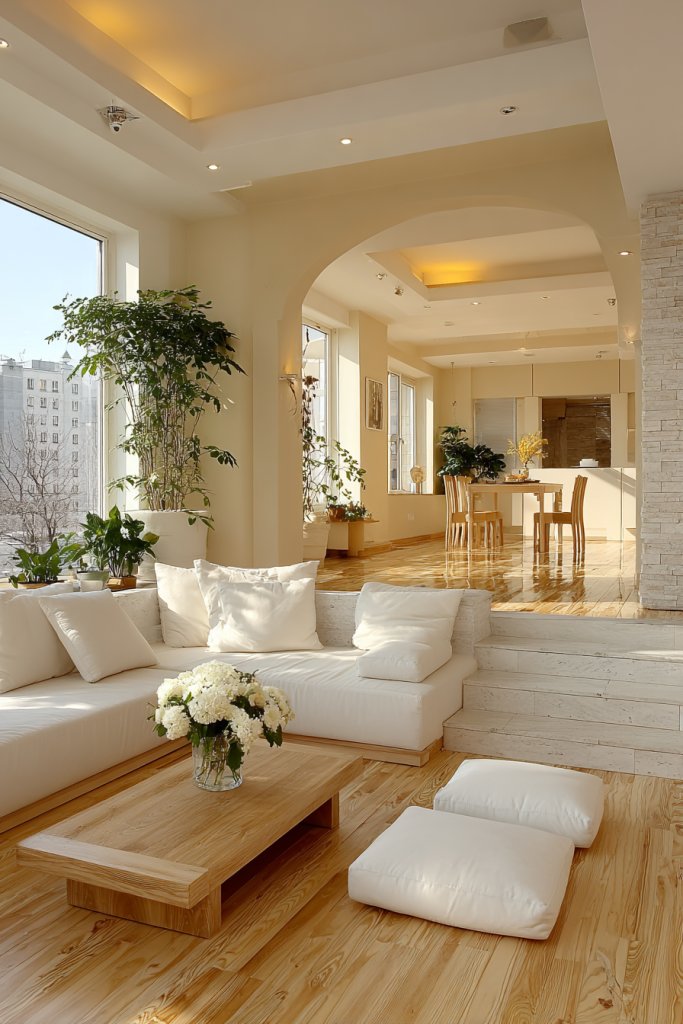
Ever felt cramped even in a small home? The lack of space can make your daily routines feel cluttered and disconnected. You crave an environment where everything feels more open and inviting, without sacrificing privacy. Open-plan living promises to turn that dream into reality, creating a sense of freedom in your home.
Imagine walking into a bright, airy space where the living, dining, and kitchen areas flow effortlessly into each other. Large windows flood the room with natural light, bouncing off neutral walls that reflect a soft glow. The space feels expansive yet cozy, with furniture arranged to encourage social interaction rather than separation. It’s a perfect setup for hosting friends or enjoying family time without barriers.
This concept adapts well to modern minimalism with sleek furniture and monochrome palettes, or to a warm rustic look with textured woods and soft textiles. Seasonal touches like lightweight curtains or fabric dividers can add privacy when needed. For smaller spaces, using transparent or open shelving can maintain the flow, while larger homes may incorporate distinct zones with subtle floor rugs or lighting differences.
Start by removing non-essential walls to open up the layout—consult a structural engineer if load-bearing walls are involved. Plan your furniture to promote flow, with low-profile pieces that don’t block sightlines. Use strategic lighting—recessed lights or wall sconces—to highlight different zones without cluttering the space. Incorporate multi-use furniture, like a sofa with built-in storage, to maximize functionality. Keep clutter out of sight with clever storage solutions tucked into corners or under stairs.
Add textured textiles like throws, cushions, and rugs to define zones and add warmth. Incorporate statement lighting fixtures, such as modern sconces or pendant lights, to create focal points. Use color accents through accessories to personalize the space, making it uniquely yours. Consider movable partitions or screens for temporary privacy during gatherings or work-from-home days.
Open-plan living elevates your home’s aesthetic and functional appeal, making it feel larger and more connected. It encourages a lifestyle centered around socializing and shared experiences. With careful planning, you can craft a space that’s both stylish and practical—ready to impress and inspire all who visit.
2. Multi-Functional Furniture for Space Optimization
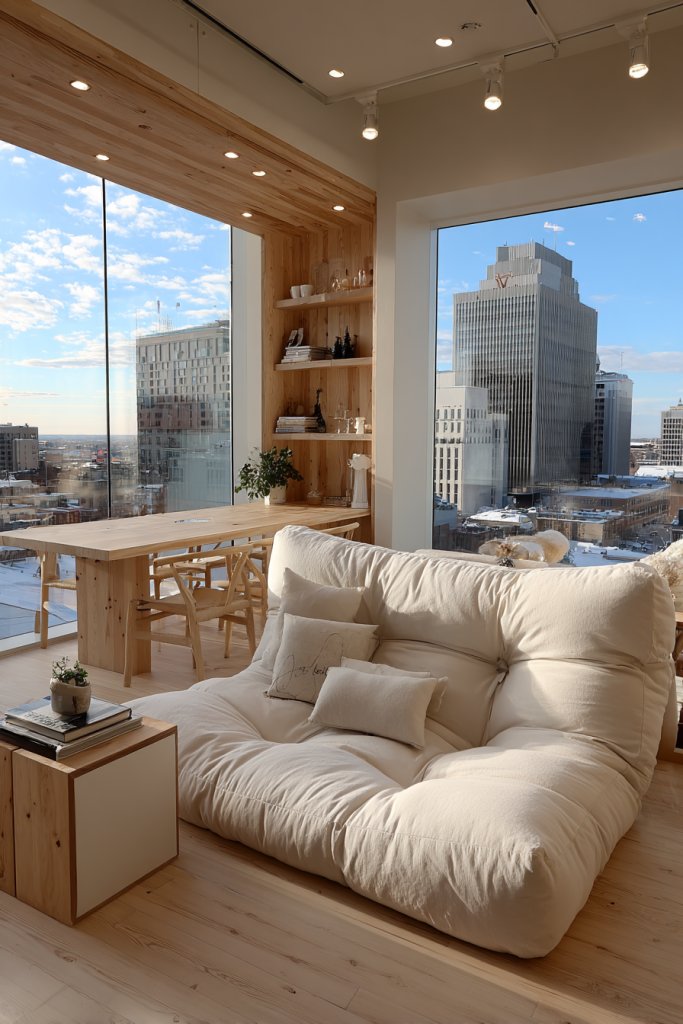
Limited space often means sacrificing comfort or style. The constant struggle is finding furniture that does double duty without looking bulky or awkward. Multi-functional furniture offers a clever solution, helping you maximize every inch while maintaining a sleek look. It’s like having a secret weapon in your decorating arsenal.
Picture a stylish sofa that folds down into a guest bed, or a coffee table that extends into a dining surface. Think of a storage ottoman that doubles as a cozy seat, hiding away blankets, books, or seasonal gear. These pieces blend seamlessly into your decor, with neutral fabrics or materials that complement your existing style. The result is a home that feels spacious, organized, and effortlessly chic.
Choose furniture in styles that match your taste—industrial with metal accents, Scandinavian with light woods, or contemporary with bold colors. Seasonal updates can include swapping covers or adding decorative cushions. For small apartments, wall-mounted fold-out beds or desks save precious floor space, while larger homes can incorporate larger multi-purpose units like modular sofas or extendable tables.
Identify your main space challenges and prioritize versatile pieces that serve more than one function. Research options with hidden compartments or convertible features, ensuring they’re both durable and easy to operate. Measure your space carefully to select sizes that fit comfortably without overcrowding. Use lightweight or modular furniture for easy rearrangement. When assembling, follow manufacturer instructions diligently to ensure longevity and safety.
Personalize your multi-functional furniture with decorative textiles or paint finishes that reflect your style. Add removable covers for seasonal or mood-based updates. Incorporate decorative trays or bowls that sit atop extendable tables or fold-out beds for extra flair. Use color coordination to unify different pieces, creating a cohesive look that’s also functional.
With clever furniture choices, your space becomes more adaptable and lively. It’s a practical way to stay organized without sacrificing style. Plus, it proves that small spaces can be both beautiful and highly livable—your home will impress anyone who visits.
3. Compact Kitchen Designs with Smart Storage Solutions
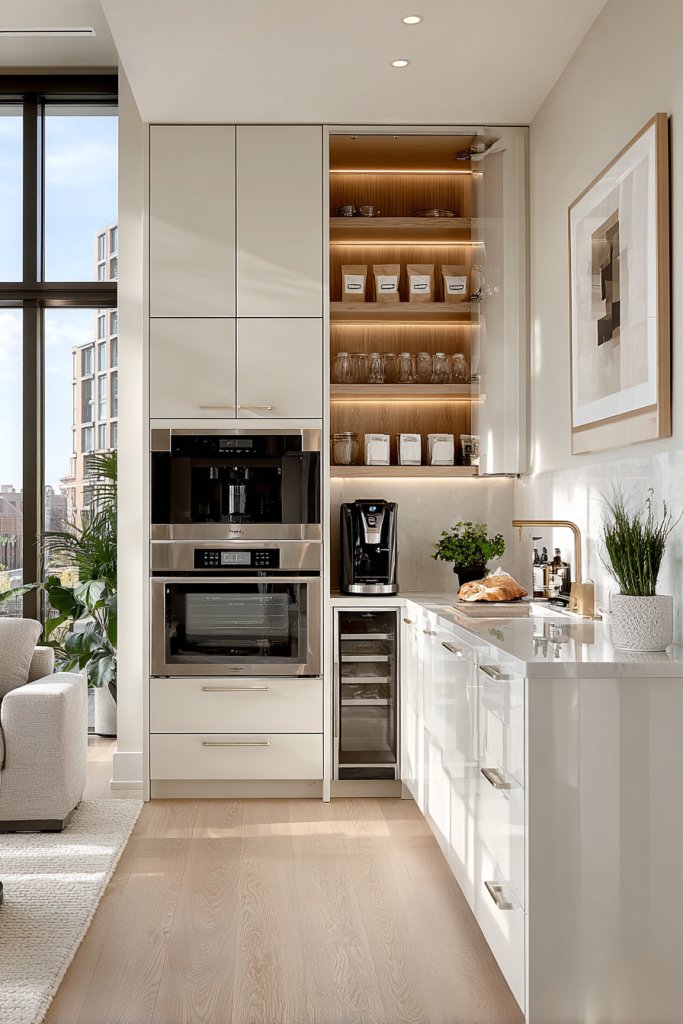
Ever felt overwhelmed by cluttered countertops and overflowing cabinets? Small kitchens often feel chaotic, making cooking less enjoyable. A compact kitchen with smart storage can transform your culinary space into an organized haven, saving time and frustration. It’s the secret to cooking happily in tight quarters.
Imagine sleek, tall cabinets reaching all the way to the ceiling, with pull-out pantry shelves filled with neatly arranged spices and ingredients. Hidden compartments keep appliances out of sight when not in use, and a compact island provides extra prep space without crowding. The overall look is clean, with a seamless flow that invites you to cook and entertain effortlessly.
Choose a minimalist style with handleless cabinets and monochrome surfaces for a modern look, or go for a cozy cottage vibe with open shelving and colorful containers. Incorporate vertical storage to free up counter space, and consider fold-away or pull-out appliances that tuck neatly into cabinets. Seasonal accessories like decorative jars or fabric covers can add personality without cluttering.
Start by analyzing your storage needs and measuring available space. Opt for vertical cabinets with adjustable shelves to maximize flexibility. Install pull-out drawers, lazy Susans, or vertical dividers to make accessing items easier. Use modular storage containers to organize smaller items, and select appliances that integrate seamlessly into cabinetry. Regularly declutter and reconfigure your storage to keep it functional.
Personalize your kitchen with colorful storage bins, stylish handles, and textured backsplashes made of textured tiles or patterned wallpaper. Incorporate under-cabinet lighting to brighten work areas and add ambiance. Use decorative magnets or labels for easy identification, and hang a few eye-catching utensils or tools on wall-mounted racks for functional decor.
A well-designed compact kitchen boosts your confidence in cooking and entertaining. Efficient storage and thoughtful organization make every meal prep a breeze. When your kitchen functions flawlessly, it encourages creativity and makes your entire home feel more inviting and manageable.
4. Minimalist Color Palettes for a Bright, Airy Atmosphere
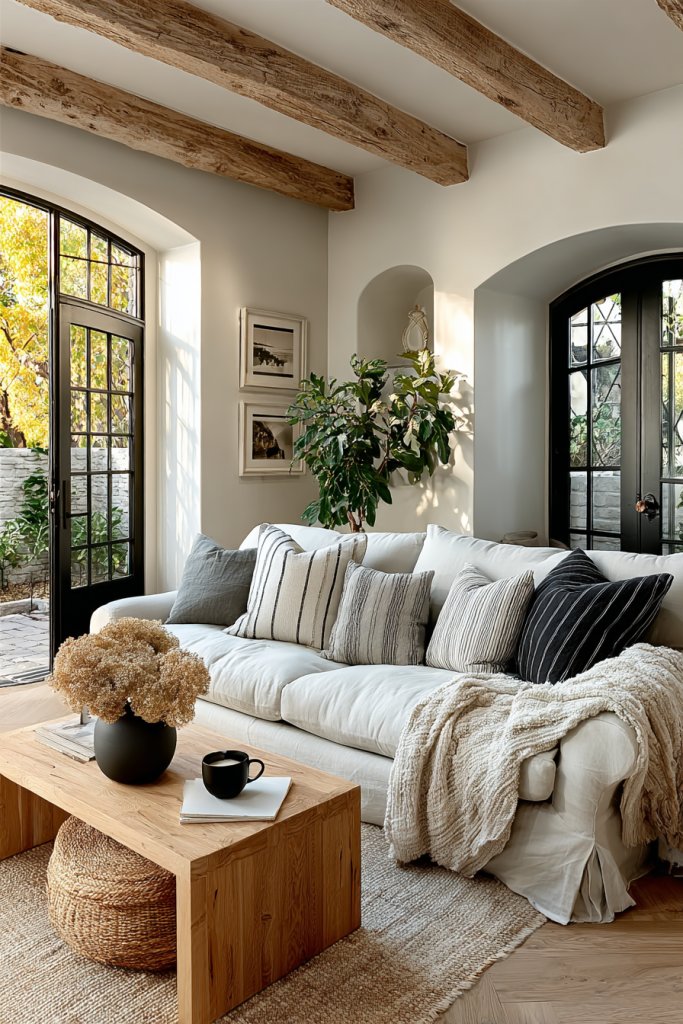
Do dark, cluttered spaces make you feel overwhelmed? A bright, airy home can boost your mood and create a calming environment. Minimalist color palettes—like whites, beiges, and soft grays—are the secret to making your space feel larger and more inviting. It’s the easiest way to refresh your home without a full renovation.
Visualize a room painted in crisp white, with accents in muted tones—think a soft cream throw blanket with chunky knit texture or a light wooden dining table. Natural light bounces off glossy or matte surfaces, creating a luminous effect. The space feels open, uncluttered, and peaceful, with subtle contrasts adding depth without overwhelming the senses. This color scheme sets a perfect backdrop for any style or season.
Layer textures like woven baskets, linen curtains, or shaggy rugs to add warmth and dimension. You can introduce gentle color accents through textiles or accessories, like blush cushions or pale blue ceramics, to break monotony. Seasonal updates could include swapping out textiles or adding darker accent pieces for contrast in winter or spring.
Start with a neutral base—paint walls with light shades and choose furniture with simple lines and soft hues. Use reflective surfaces like mirrors or glossed tiles to enhance light. Incorporate natural materials like wood, cotton, or jute to add organic warmth. Keep accessories minimal but intentional, focusing on quality over quantity. Regularly declutter to maintain the clean, minimal aesthetic.
Introduce personal touches with textured throws, decorative cushions, or subtle metallic accents. Use dimmable lighting to adjust mood and highlight textures. Opt for simple, functional decor pieces that add personality without cluttering the space. Remember, less is more—let each element breathe.
A minimalist palette creates a timeless, versatile foundation that can evolve with your style. It’s a low-maintenance, stress-free approach to decorating that ensures your home always looks fresh and inviting. Embrace simplicity and enjoy a more peaceful living space that truly feels like home.
5. Large Windows and Sliding Glass Doors for Natural Light
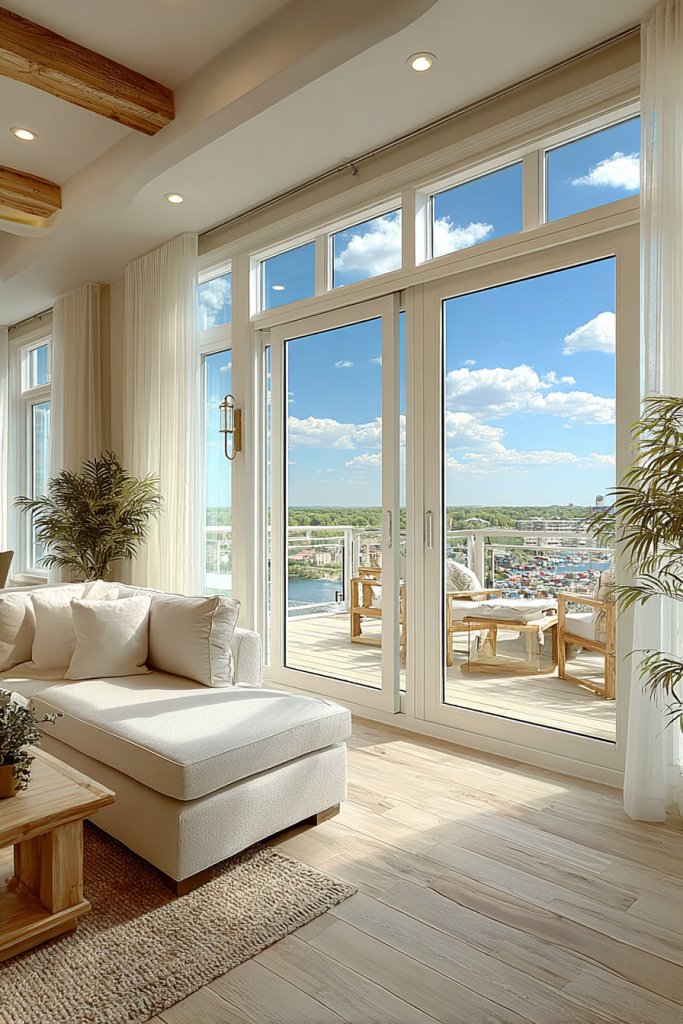
Feeling closed off and dark inside your home? Natural light is a game-changer, making spaces feel larger, more welcoming, and healthier. Large windows and sliding glass doors unlock that potential, blurring the lines between indoors and outdoors. It’s like bringing the sunshine inside, anytime you want.
Picture expansive glass panels that stretch from floor to ceiling, framing a view of your garden or patio. During the day, sunlight floods the room, bouncing off light-colored walls and textured floors, creating a sense of openness. Sliding doors open seamlessly to a covered patio, inviting fresh air and outdoor living. The visual connection with nature enhances tranquility and aesthetic appeal.
For a sleek modern look, choose frameless or minimal-frame glass doors. In more traditional homes, ornate or divided panes add character. Consider adding outdoor shades or curtains to control glare and privacy when needed. Seasonal decor can include outdoor furniture or textured rugs just outside the glass doors for a cozy transition inside.
Work with a professional to ensure proper structural support for large openings. Use energy-efficient, double-glazed glass to improve insulation. Select sliding mechanisms that glide smoothly and lock securely. Incorporate low-profile thresholds for accessibility and safety. Plan the layout so furniture placement doesn’t obstruct views or access to the doors.
Decorate outside with lighting or textured outdoor textiles to create a seamless indoor-outdoor vibe. Inside, use light-colored or sheer window treatments to maximize light without sacrificing privacy. Add personal touches like a cozy seating area just inside the doors to encourage outdoor lounging or entertaining.
Large windows and sliding doors can dramatically elevate your home’s ambiance, making it feel expansive and connected to nature. They help you enjoy natural light, reduce energy costs, and boost overall happiness in your daily life. Go big, and let your home shine.
6. Skylights and Roof Windows to Maximize Daylight
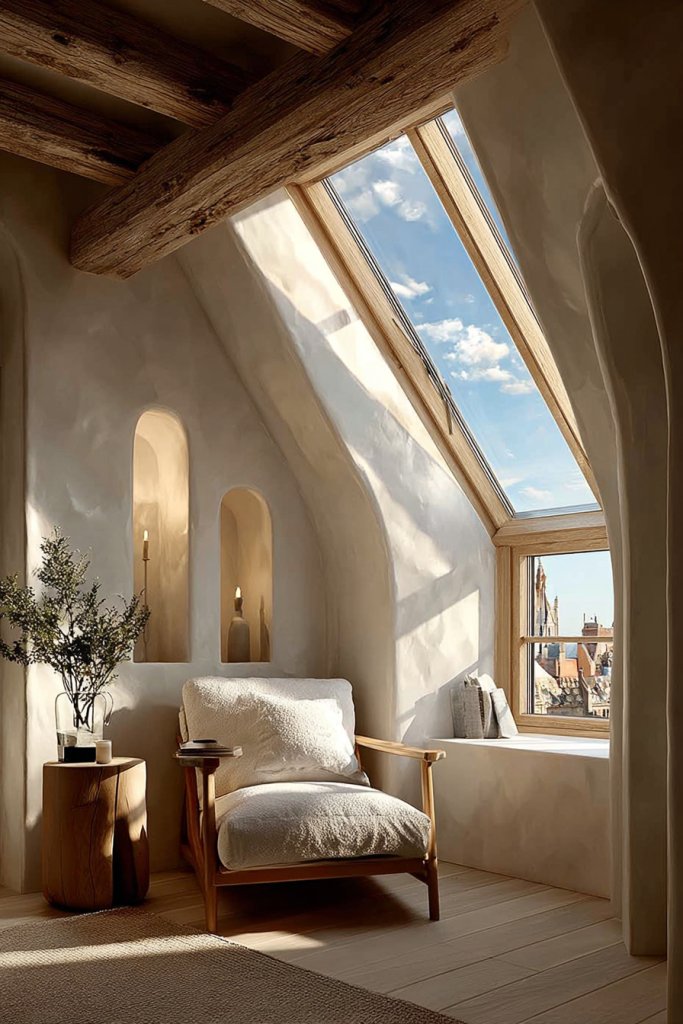
Ever wish your home could soak up more sunlight without adding more windows? Skylights and roof windows provide overhead natural light that brightens even the darkest corners. They make your home feel more spacious and inviting, reducing the need for artificial lighting during the day. Plus, they add a touch of architectural wow factor.
Imagine a sleek skylight set into a vaulted ceiling, casting a soft glow on your living space. The light filters through translucent blinds or reflective surfaces, creating dancing patterns that change with the time of day. In a cozy bedroom or bathroom, a roof window offers a view of the sky, adding a serene, open-air vibe that feels almost outdoors.
Opt for fixed or operable skylights, depending on ventilation needs. Use blackout blinds or shades for privacy and light control, especially in bedrooms. Incorporate reflective paint or light-colored ceilings to amplify the daylight effect. Seasonal decor can include lightweight drapes or fabric panels that add texture without blocking light.
Choose high-quality, energy-efficient skylights with UV protection. Work with a roofing specialist to ensure proper installation, sealing, and insulation to prevent leaks. Select models with ventilation options for fresh air and temperature regulation. Position skylights to maximize sunlight exposure based on your home’s orientation. Regular maintenance ensures clear, unobstructed daylight.
Decorate around skylights with reflective or textured surfaces to enhance light diffusion. Use light, airy curtains or fabric panels that complement your decor. Inside, add subtle lighting layers—like wall sconces or indirect lighting—to enhance the natural glow during cloudy days or evenings.
Skylights and roof windows are stylish, functional upgrades that boost your home’s natural light and energy efficiency. They create a brighter, happier living space that feels larger and more connected with the sky. Brighten your home and your outlook—sky’s the limit.
7. Built-In Storage Solutions to Reduce Clutter
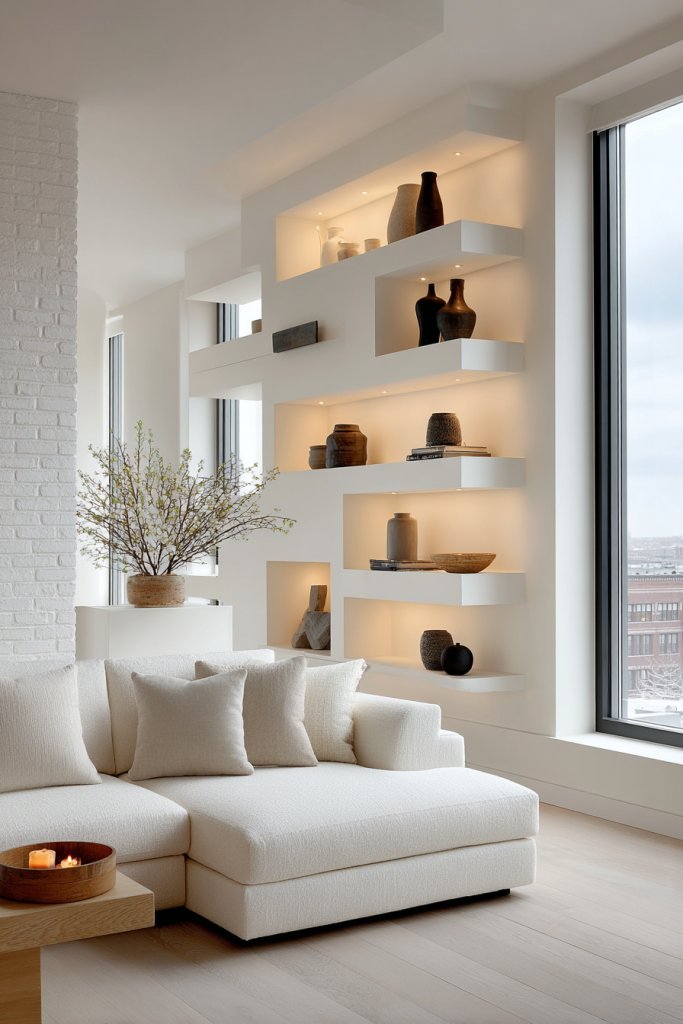
Clutter can quickly turn a beautiful home into chaos. Finding enough storage without sacrificing style is a challenge many face. Built-in storage solutions cleverly hide away essentials, keeping your space tidy and visually appealing. They turn wasted wall or corner areas into functional, neat compartments that make life easier.
Visualize sleek wall-mounted shelves that blend into your decor, holding only the essentials or decorative items. Under-stair cabinets or recessed wall niches hide away shoes, cleaning supplies, or seasonal gear. Custom closets with sliding or fold-out doors keep everything out of sight, maintaining a clean aesthetic. These solutions create a seamless, organized environment where everything has its place.
Choose minimalist designs with flat-front doors for a modern look, or ornate cabinetry for a classic vibe. Incorporate open shelving for frequently used items, balanced with closed cabinets for hidden storage. Color-match cabinetry with your walls or furniture for a unified appearance. Seasonal or decorative accents can be added, such as textured finishes or decorative handles, to personalize the look.
Begin by evaluating your storage needs and available wall or corner space. Work with a carpenter or use modular systems to design custom solutions tailored to your layout. Use high-quality materials like plywood or MDF with a durable finish for longevity. Install hidden hinges or soft-close mechanisms for a premium feel. Keep accessibility in mind—place frequently used items at eye level or within easy reach.
Add decorative touches like patterned or textured cabinet doors, or install LED lighting inside cabinets for visibility. Use organizational accessories—like pull-out baskets or dividers—to keep items sorted. Personalize with labels or color-coded bins that match your style. Keep the overall look clean and cohesive, ensuring the storage enhances rather than overwhelms your space.
Built-in storage solutions streamline your space, making it more functional and visually serene. They demonstrate smart design thinking that transforms chaos into calm. With these clever solutions, your home becomes a sanctuary of order and style—proof that small space living can be both beautiful and practical.
8. Outdoor-Indoor Living with Covered Patios
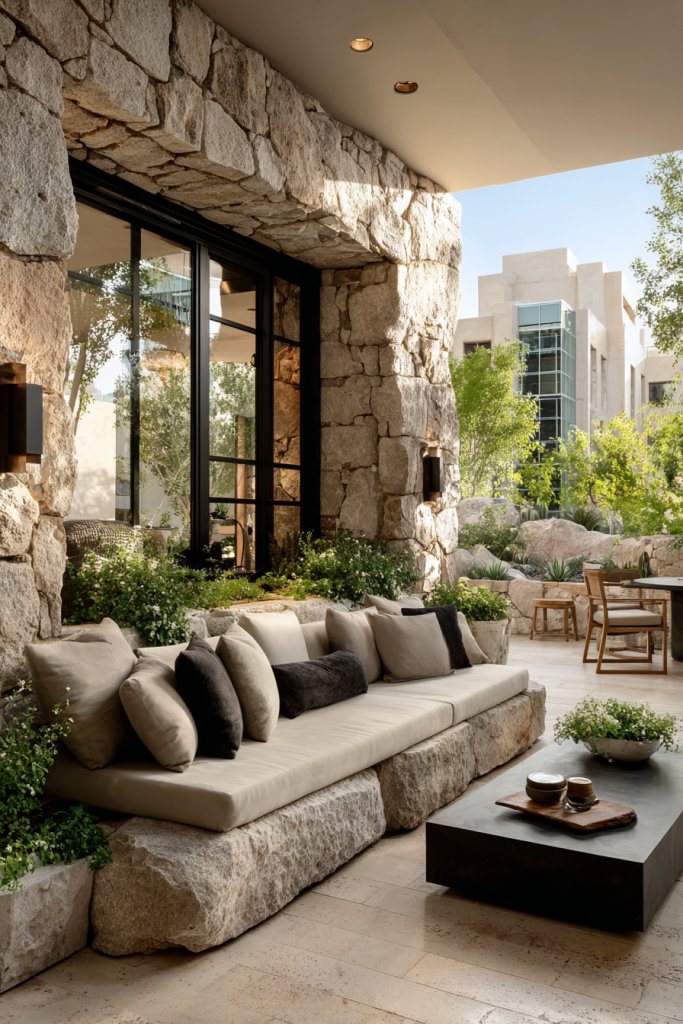
Craving more connection with nature but limited by space or weather? Covered patios bridge the gap between indoors and outdoors, creating versatile living areas. They extend your home’s usable space and invite fresh air and sunshine without the unpredictability of the elements. It’s a smart way to enjoy outdoor living all year round.
Picture a cozy, covered patio with a textured stone or wooden floor, furnished with weather-resistant seating and a small dining table. Soft outdoor lighting casts a warm glow in the evening, while ceiling fans or heaters add comfort. The space flows seamlessly from your living room through large sliding doors, with lush greenery or decorative screens adding privacy and style. It’s a perfect spot for morning coffee or evening gatherings.
Create a rustic vibe with exposed beams and natural materials, or opt for sleek, modern finishes with glass and metal accents. Use outdoor fabrics and cushions in vibrant colors or patterns to add personality. Seasonal adaptations include removable screens or curtains to control sun and wind, while adding heaters or fans extends usability into cooler or hotter months.
Work with a contractor to ensure proper roofing, drainage, and structural support. Select weather-resistant materials such as composite decking, treated wood, or stone tiles. Install ceiling fans, lighting, and possibly outdoor heating elements—keeping electrical systems weatherproof. Position furniture for optimal views and accessibility, and consider retractable screens or glass panels for flexibility. Regular maintenance keeps it looking fresh and functional.
Personal touches include decorative outdoor rugs, textured cushions, and lantern-style lighting. Planting in containers or hanging baskets adds color and life, with options to swap seasonal blooms. Incorporate personal items like a fire pit or small water feature for a peaceful retreat. Use weatherproof artwork or sculptures to add interest without sacrificing practicality.
A covered outdoor space enhances your home’s livability and value, making every day feel like a vacation. It encourages outdoor gatherings and creates a retreat that’s both functional and stylish. With thoughtful design, your outdoor-indoor living area becomes a cornerstone of your home’s happiness and charm.
9. Vertical Gardening and Green Walls for a Touch of Nature
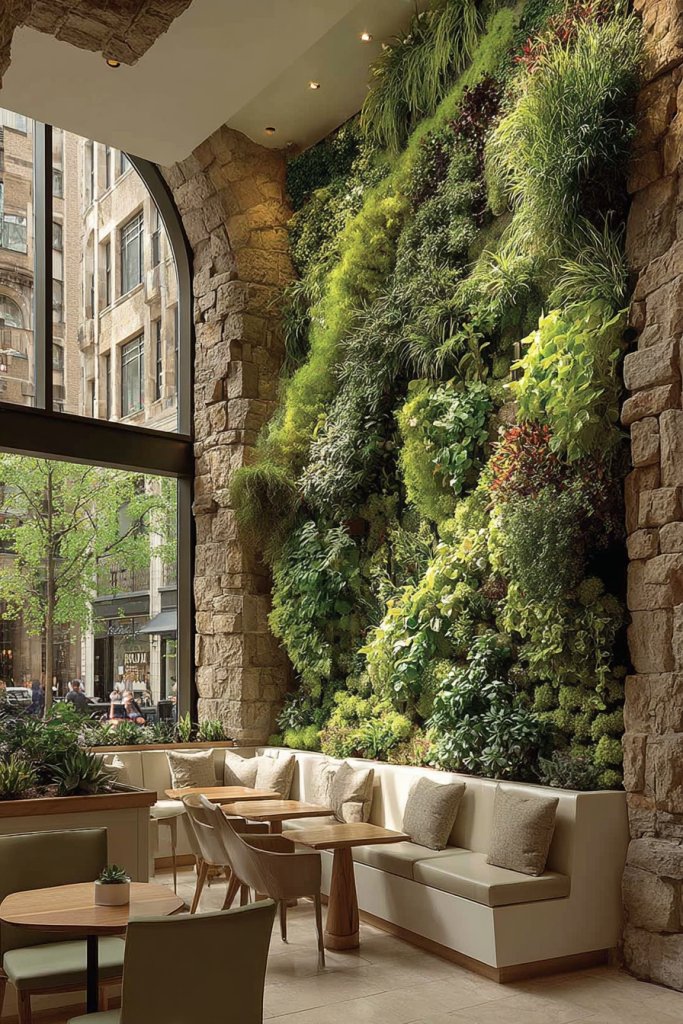
Lacking yard space but craving greenery? Vertical gardens and green walls offer a lush solution that fits into even the smallest homes. They bring life and color indoors, improving air quality and adding a vibrant focal point. Who says you need acres to enjoy nature’s calming influence?
Imagine a textured wall covered in a mosaic of lush, leafy plants cascading from sleek planters or built-in pockets. The greenery softens stark walls, adds depth, and creates a soothing backdrop. Natural light filters through, highlighting the vibrant hues and textures of the foliage, creating a miniature indoor oasis that feels alive and refreshing.
Choose low-maintenance plants suited for indoor environments, like succulents or ferns, arranged in modular panels or fabric pockets. For a modern aesthetic, use geometric planters or sleek metal frames. Seasonal updates can include colorful flowers or decorative moss, and lighting can be integrated with LED strips for a dramatic effect. Keep in mind that watering systems or self-watering planters simplify maintenance.
Select a suitable wall—preferably with good natural light or install grow lights. Mount modular panels, planters, or grid systems designed for vertical gardens. Use waterproofing solutions and ensure proper drainage to prevent damage. Choose plants that thrive indoors and require similar care, grouping them for easier maintenance. Regular pruning and watering keep the garden lush and healthy.
Personalize with decorative containers or labels that match your decor style. Incorporate textured fabrics or materials behind the wall to add contrast. Consider adding small sculptures or stones for visual interest. You can even create themed sections—herbs, flowering plants, or succulents—to suit your lifestyle and taste.
Vertical gardens turn limited space into a visual masterpiece, combining beauty and function. They offer a refreshing escape from urban monotony, making your home feel closer to nature. With minimal effort, you can enjoy a greener, healthier environment that boosts your mood and well-being.
10. Compact Home Office Nooks for Remote Work
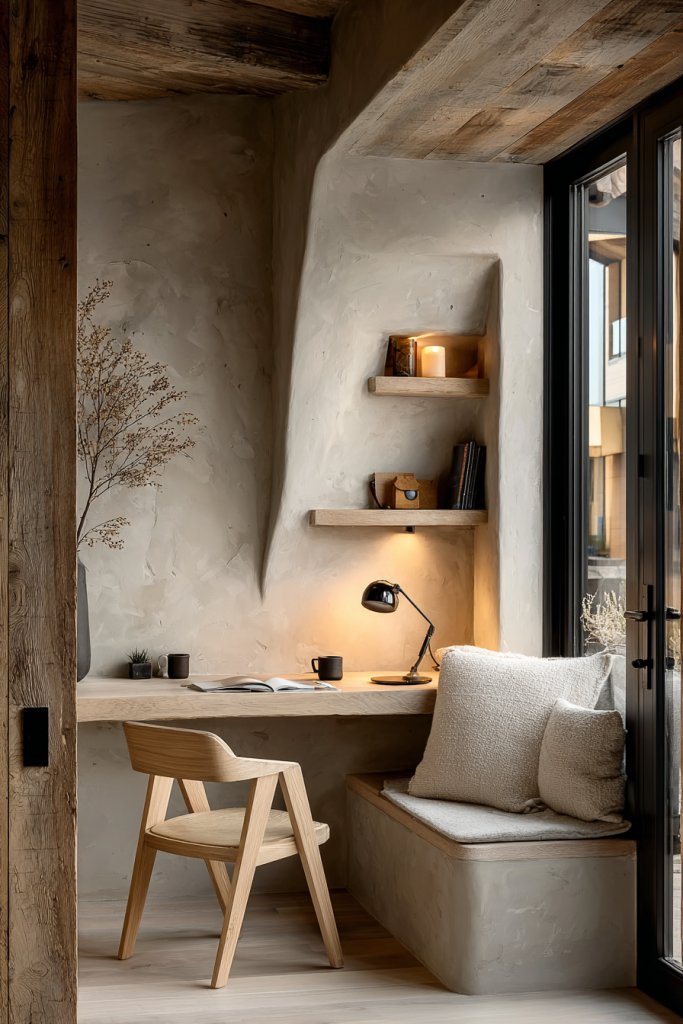
Working from home sounds ideal until your space turns into a cluttered chaos zone. Creating a dedicated, compact office nook helps separate work from leisure, boosting productivity and reducing stress. It’s the perfect solution for small homes where space is at a premium but focus is non-negotiable.
Picture a cozy corner tucked behind a sliding door or under a staircase, featuring a wall-mounted desk with sleek shelving above. Soft lighting, a comfortable chair, and organized storage keep the area functional and inviting. The space feels intentional—quiet, efficient, and personalized—making it easy to shift into work mode without distractions.
Choose minimalist desks with hidden cable management for a clean look. Add floating shelves for books or supplies, and incorporate decorative storage bins for neatness. For a cozy vibe, use textured textiles or colorful accessories that reflect your personality. Seasonal updates might include new artwork or fresh desk accessories to keep the space inspiring.
Identify a quiet corner with good natural light or add task lighting for evening work. Mount a narrow desk or fold-down surface that can be tucked away when not in use. Use wall-mounted organizers or pegboards for tools and supplies, minimizing clutter. Ensure your chair and desk height promote comfort, and add noise-canceling elements if needed. Install power outlets and internet connections in strategic locations for efficiency.
Decorate with a favorite color scheme or inspirational quotes to stay motivated. Use textured wall panels or patterned wallpaper behind the workspace to add visual interest. Incorporate a small plant or decorative object that sparks joy, without overloading the space. Keep the area tidy with stylish containers or a compact filing system.
A dedicated work nook boosts your productivity and helps maintain work-life balance. It proves that even small spaces can support big ambitions. By creating a functional and inspiring environment, you set yourself up for success every day—no excuses needed.
11. Efficient Bathroom Layouts with Space-Saving Fixtures
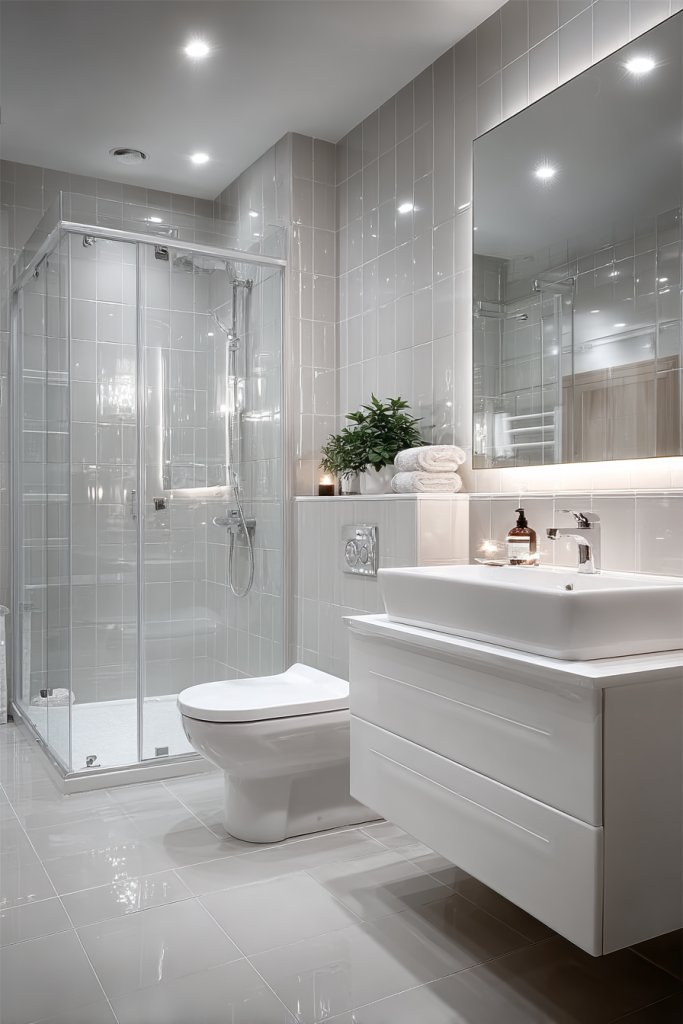
Small bathrooms often feel cramped, cluttered, and inefficient. Finding ways to optimize space without sacrificing comfort can transform your daily routine. Space-saving fixtures are the secret weapon—making your bathroom feel larger, more functional, and easier to keep tidy.
Imagine a corner-mounted sink with a slim profile, paired with a wall-hung toilet that frees up floor space. A glass shower enclosure with built-in niches offers storage without bulk, while a compact vanity provides just enough storage for essentials. Light-colored tiles and sleek fixtures reflect light, creating an airy, open atmosphere. It’s a bathroom designed for both function and style.
Choose fixtures with clean lines and minimalist designs to maximize visual space. Incorporate niches or recessed shelves within shower walls for toiletries, avoiding cluttered counters. Consider floating vanities or wall-mounted cabinets to free up floor space. Seasonal updates include swapping out towels or adding textured mats for comfort and freshness.
Select compact, water-efficient fixtures that fit your space and needs. Work with a plumber to ensure proper installation and drainage. Use transparent or frosted glass for showers to enhance openness. Maximize vertical space with wall-mounted towel racks or hooks. Regularly clean and maintain fixtures to keep everything functioning smoothly and looking new.
Add textured wall tiles or patterned flooring to create visual interest. Incorporate stylish storage baskets or sleek containers to organize toiletries. Use soft, neutral colors for a calming effect, or add a pop of color with accessories like towels or mats. Keep decor simple to maintain a clutter-free vibe.
A well-designed, space-efficient bathroom elevates your home’s overall aesthetic. It simplifies daily routines and makes cleaning easier. With clever fixtures and layout, even the smallest bathroom can feel luxurious and functional—proof that good design transforms every inch.
12. Cozy Reading Corners with Built-In Shelving
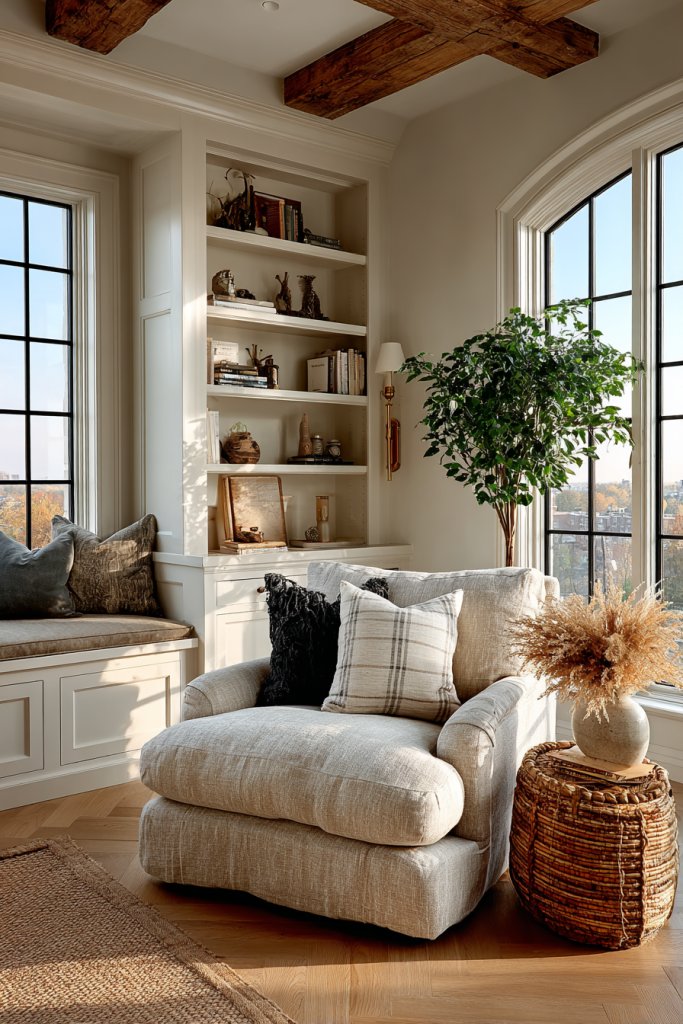
Do you dream of a quiet escape within your own home? A cozy reading corner offers a personal retreat where you can unwind with a good book. When paired with built-in shelving, it becomes a stylish nook that maximizes space and adds character. It’s the perfect spot to relax and recharge.
Visualize a small alcove with a plush armchair or cushioned window seat, flanked by custom-built shelves filled with your favorite reads. Soft lighting, like a wall-mounted sconce or a small table lamp, creates a warm glow. Textured cushions and throws add comfort, while the surrounding shelves provide a gallery of books and decorative objects. It’s a charming hideaway that beckons you to stay awhile.
Choose shelving styles that match your decor—sleek, modern units or rustic, open wood shelves. Incorporate hidden compartments or drawers for extra storage of reading accessories. Seasonal updates include swapping out cushion covers or adding textured throws. You can also add a small side table or ottoman for convenience.
Identify a quiet corner or underutilized space, such as under stairs or beside a window. Build or install custom shelving that fits your wall dimensions, ensuring easy access to books. Add a comfortable seat with supportive cushions, and install soft lighting to create ambiance. Keep the area tidy with small baskets or organizers for magazines or reading glasses. Regularly refresh your book collection to keep the space inviting.
Decorate shelves with decorative objects or framed photos that reflect your personality. Use textured or patterned cushions to add visual interest. Consider adding a small plant or scented candle for a calming atmosphere. Personal touches make the space uniquely yours, encouraging frequent visits.
A dedicated reading nook transforms a simple corner into a personal sanctuary. It encourages relaxation, learning, and a moment of peace in your busy life. With a little effort, you create a stylish, functional space that nurtures your love of reading and self-care.
13. Multi-Functional Entryways with Storage Bench and Hooks
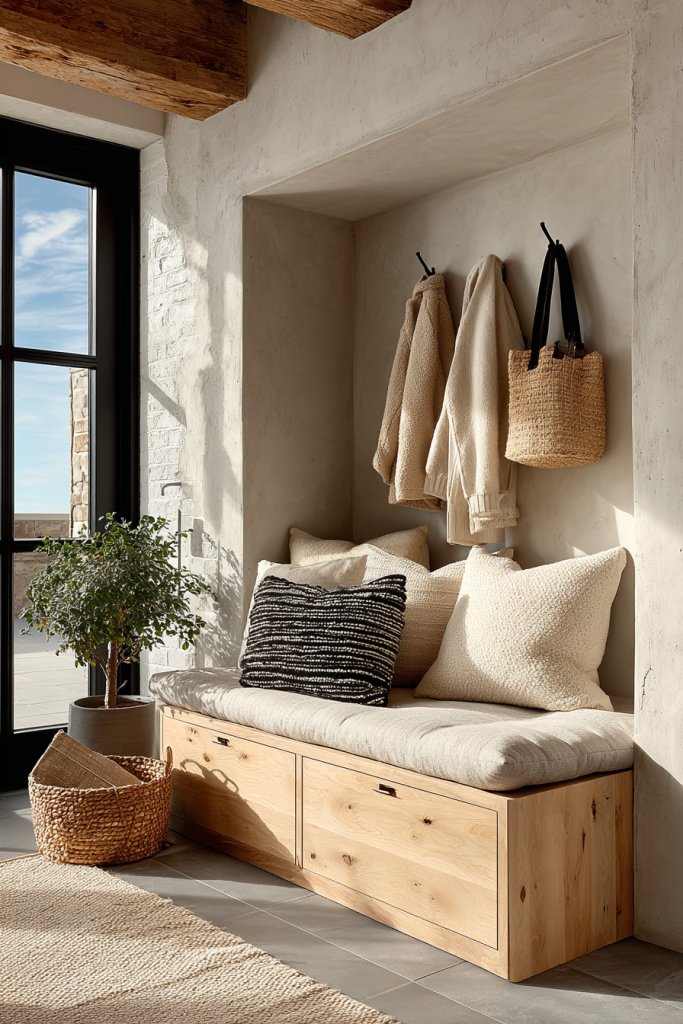
Is your entryway cluttered with shoes, coats, and bags? An organized, multi-functional entry space makes coming and going smoother and less stressful. Combining a storage bench with hooks and shelves optimizes space and keeps essentials within arm’s reach. It’s the first impression your home deserves—and it sets the tone for a tidy lifestyle.
Picture a sleek bench with hidden compartments beneath, topped with a soft cushion and surrounded by wall-mounted hooks for coats and bags. Above, floating shelves hold keys, sunglasses, or decorative items, adding personality. The entire setup feels balanced and inviting, with a neutral color palette and textured finishes that match your decor. It’s a functional piece that welcomes guests and keeps your daily essentials organized.
Choose a bench style that complements your decor—industrial metal, rustic wood, or minimalist designs. Incorporate hooks in different sizes and styles for versatility. Seasonal updates include swapping cushions or adding decorative baskets below. For smaller entries, opt for wall-mounted shelves and compact seating to maximize space.
Start by measuring your space and selecting a sturdy bench with built-in storage. Install wall hooks or a coat rack at varying heights to accommodate all family members. Add floating shelves for display or extra storage, ensuring they are securely anchored. Use decorative baskets or bins inside the bench or beneath for shoes and accessories. Keep the area clutter-free with designated spots for each item.
Personalize with colorful cushions, textured fabrics, or decorative hangings that match your style. Add a mirror above the bench to make the space appear larger and for last-minute checks. Use labels or color coding for keys and accessories to streamline routines. Incorporate seasonal decor for a fresh look throughout the year.
A well-organized entryway simplifies your daily routines and reduces stress. It makes your home feel welcoming and thoughtfully designed. Even small changes can have a big impact—turning chaos into calm and impressing everyone who steps inside.
14. Use of Reflective Surfaces to Enhance Light and Space
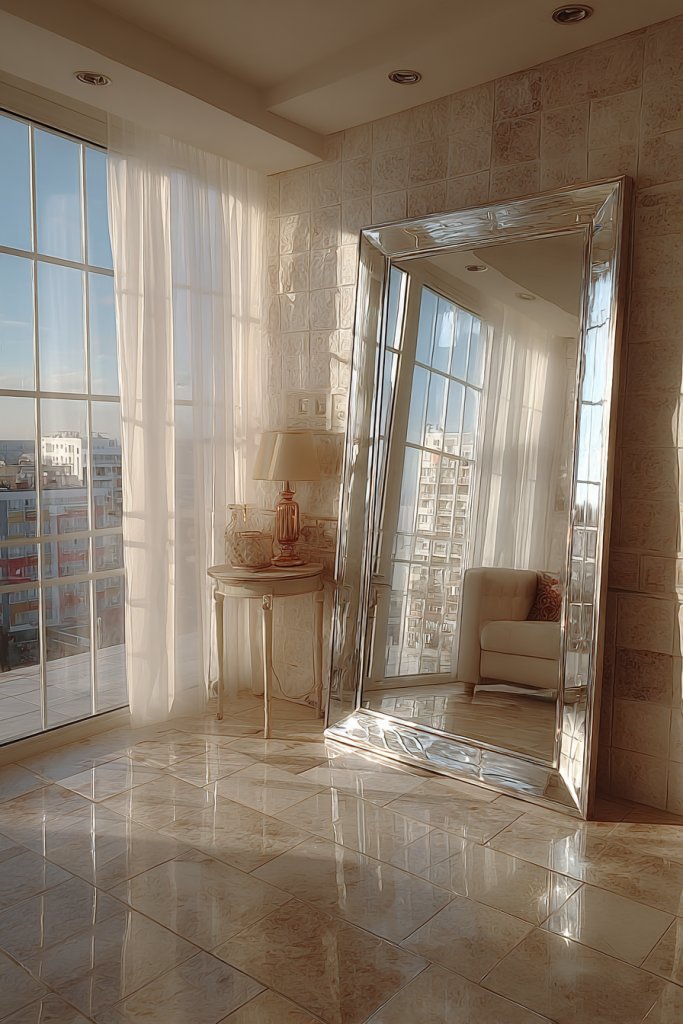
Dark, cramped rooms can drain your energy and make your home feel smaller than it is. Reflective surfaces—like mirrors, glossy tiles, or metallic accents—bounce light around, instantly brightening your space. They create the illusion of depth and openness, making any room feel more expansive and lively.
Imagine a large mirror mounted opposite a window, amplifying natural light and reflecting a vibrant, textured wall. Glossy tiles in the kitchen or bathroom reflect light, giving a clean, fresh look. Metallic fixtures or decorative accents add a touch of sophistication, catching the eye and illuminating the room. The overall effect is a space that feels double in size and full of energy.
Choose mirrors with decorative frames to add personality or sleek, frameless designs for a minimalist aesthetic. Use reflective furniture surfaces—like a lacquered coffee table or high-gloss cabinets—to increase brightness subtly. Incorporate metallic accessories like lamps, handles, or picture frames to add contrast and shine. Seasonal updates include swapping out accessories or adding new mirror art for variety.
Place large mirrors strategically to reflect natural or artificial light, considering the layout and scale. Use glossy or high-sheen tiles and finishes in areas prone to moisture or high traffic. Install metallic fixtures or decorative hardware that complement your decor style. Keep surfaces clean and streak-free for maximum effect. Regularly update or reposition mirrors as your space evolves.
Decorate mirror frames or surfaces with textured trims or painted accents to match your decor. Incorporate metallic or reflective accessories in your decor scheme—like vases, trays, or wall art—to add visual interest. Use lighting that highlights reflective surfaces, such as sconces or LED strips. Personal touches like framed photos or artwork can also benefit from the light-enhancing effects.
Reflective surfaces are simple yet powerful tools to elevate your home’s ambiance. They enhance natural light, reduce the need for artificial lighting, and make your space feel larger and more inviting. With a few strategic updates, your home becomes brighter, more stylish, and more energetic—proof that small details can make a big difference.
15. Compact Laundry Areas with Efficient Storage
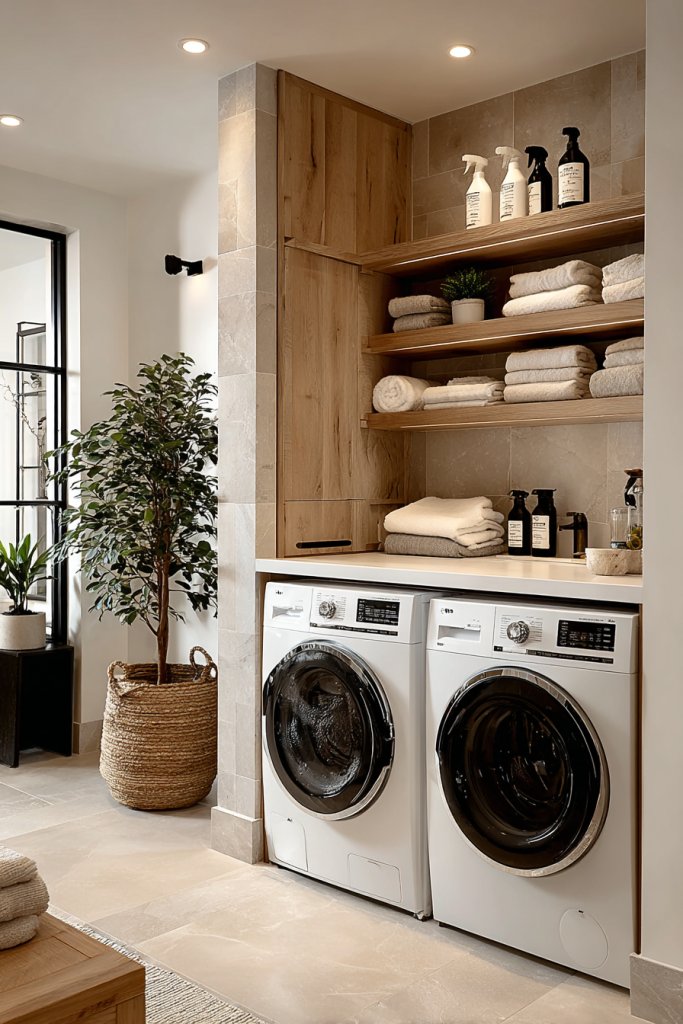
Laundry day is often a chaotic mess, especially in small homes. A compact, organized laundry area can make the chore less daunting and more manageable. Efficient storage solutions keep detergents, tools, and clothes organized, saving you time and frustration. It’s a small change that can transform your entire routine.
Visualize a narrow closet with stackable washer and dryer units, topped with a slim countertop for folding. Recessed cabinets hold supplies, while a hanging rod keeps freshly washed clothes ready for the closet or drawers. The space feels tidy and functional, with a light color scheme and sleek hardware that makes it feel bigger. It’s a practical, no-nonsense zone designed for efficiency.
Choose front-loading washers and compact dryers that fit into tight spaces. Incorporate open shelves or pull-out baskets for easy access to supplies. Use moisture-resistant finishes and light colors to keep the area bright. Seasonal updates include changing out fabric baskets or adding decorative labels for better organization.
Measure your available space carefully and select stacking units or narrow models that fit. Install wall-mounted shelves or cabinets for detergents and cleaning tools, ensuring easy reach. Use hooks or rods for hanging clothes or accessories. Consider adding a fold-down drying rack for versatile use. Keep the area well-ventilated and clean for long-term efficiency.
Personalize with color-coordinated containers, labels, or decorative tiles to make the space inviting. Add a small plant or scented diffuser to improve the atmosphere—plant choices should be low-maintenance and space-friendly. Use stylish baskets or bins that match your decor for storing laundry essentials. Keep everything tidy with designated spots for each item.
A streamlined laundry space makes this never-ending chore less of a burden. It proves that even small areas can be highly functional and stylish. When your laundry routine is organized and efficient, you save time and reduce stress—making home life smoother and more enjoyable.
16. Zone Dividers Using Furniture and Rugs
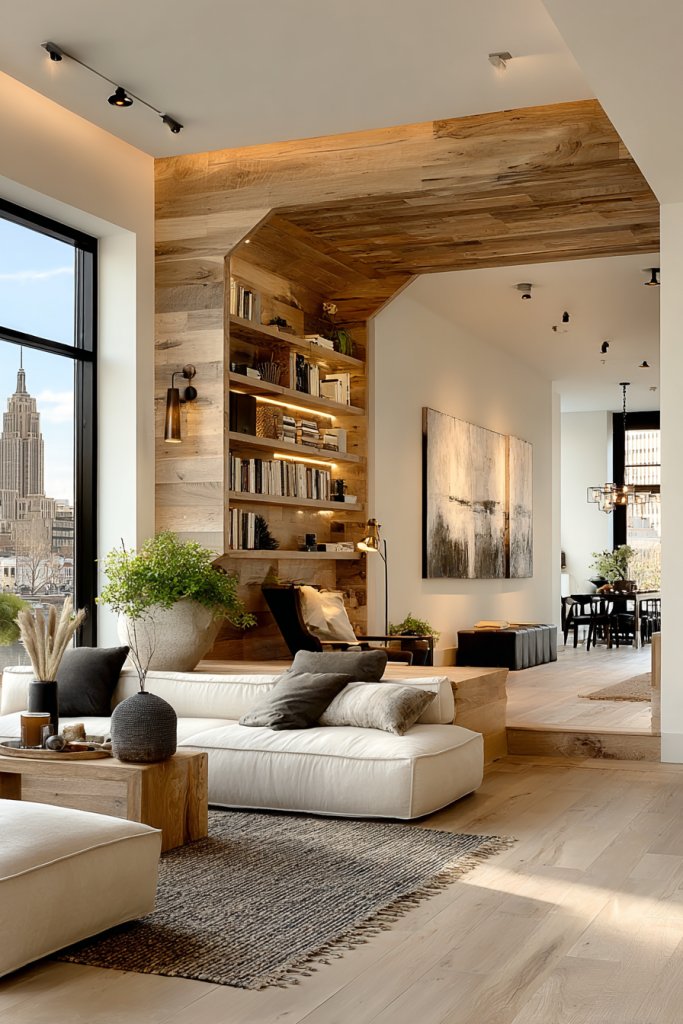
Open-concept spaces can feel chaotic without clear boundaries. Zone dividers help define different areas—like living, dining, or work zones—without installing walls. They create visual cues that organize your home, making it feel intentional and harmonious. It’s the perfect trick to keep your space flowing while maintaining order.
Imagine a plush area rug anchoring your seating area, with a sleek bookshelf acting as a partial divider behind it. A row of low-profile cabinets or a sofa with a backrest visually separates the dining space from the living room. Ambient lighting and coordinated furniture styles tie the zones together, forming a cohesive yet distinct environment. The overall look is inviting, organized, and stylish.
Use different rugs, furniture arrangements, or open shelving units to create distinct zones. For a soft transition, choose rugs with different textures or patterns. For a more modern look, opt for glass or metallic screens that add a sleek element. Seasonal updates include changing rug colors or adding decorative pillows that match each zone’s theme.
Identify the function of each zone and choose furniture or decor that visually separates them. Use area rugs or low partitions to create a clear boundary, ensuring they don’t block sightlines or traffic flow. Position furniture to encourage natural flow from one zone to another. Use lighting to highlight each area and add coherence. Regularly reassess the layout to keep the zones functional and balanced.
Personalize each zone with specific accessories—like throw pillows, artwork, or decorative objects—that reflect their purpose. Layer different textures, such as plush rugs or woven baskets, to add depth. Incorporate subtle color schemes or themes for each zone to enhance visual differentiation. Keep clutter out of sight to maintain a clean, organized look.
Using furniture and rugs as zone dividers makes your open space feel more structured and comfortable. It encourages better flow and makes your home feel larger and more curated. With a little planning, you turn a chaotic area into a harmonious sanctuary—proof that smart design makes all the difference.
17. Minimalist Staircases with Open Railing Designs
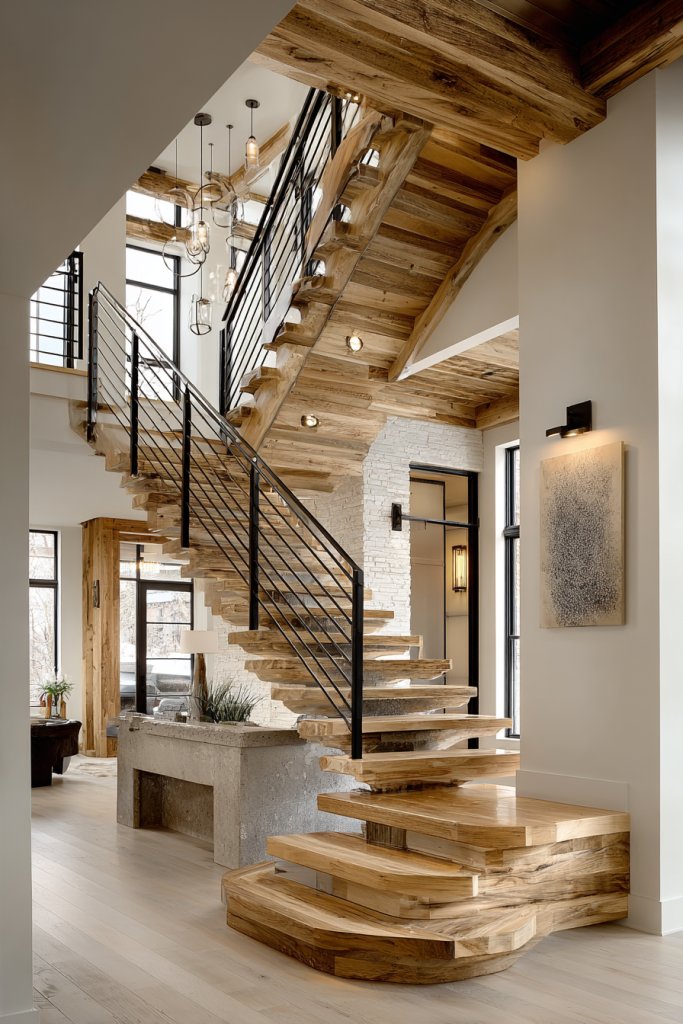
Traditional staircases can feel bulky and heavy, especially in small or open-plan homes. Minimalist staircases with open railing designs create a sense of lightness and openness. They add a modern touch while making your space feel larger and more connected. It’s a simple upgrade with a big visual impact.
Visualize a sleek staircase with thin metal or glass railings that seem to float in space. The treads are made of light wood or polished concrete, blending seamlessly with the surrounding decor. Open risers allow light to pass through, eliminating visual barriers. The overall effect is a sculptural element that enhances the home’s contemporary aesthetic.
Choose open-riser stairs with minimalist materials—like steel, glass, or light wood—for a clean look. Incorporate integrated lighting along the edges or underneath for a dramatic effect. For a softer approach, add textured or patterned treads that bring subtle character. Seasonal updates include changing lighting or adding decorative elements underneath or around the stairs.
Work with a structural engineer or architect to ensure safety and stability, especially with open risers. Select materials that are durable and match your decor, considering slip resistance and ease of maintenance. Install the staircase with minimal hardware for a seamless look. Use LED strip lighting for a modern glow, and ensure the railing height complies with safety standards. Regular inspections maintain safety and appearance.
Personalize your staircase with custom finishes—like painted risers or textured treads—that reflect your style. Incorporate subtle lighting accents or decorative handrails for added flair. Keep the surrounding area clutter-free to emphasize the staircase’s sculptural form. Add a small plant or sculpture nearby for a curated look.
Minimalist staircases elevate your home’s aesthetic and create a sense of openness. They prove that functionality can be beautiful and unobtrusive. With thoughtful design, your staircase becomes a statement piece that enhances your entire space—proof that less truly is more.
18. Energy-Efficient Design with Insulation and Ventilation
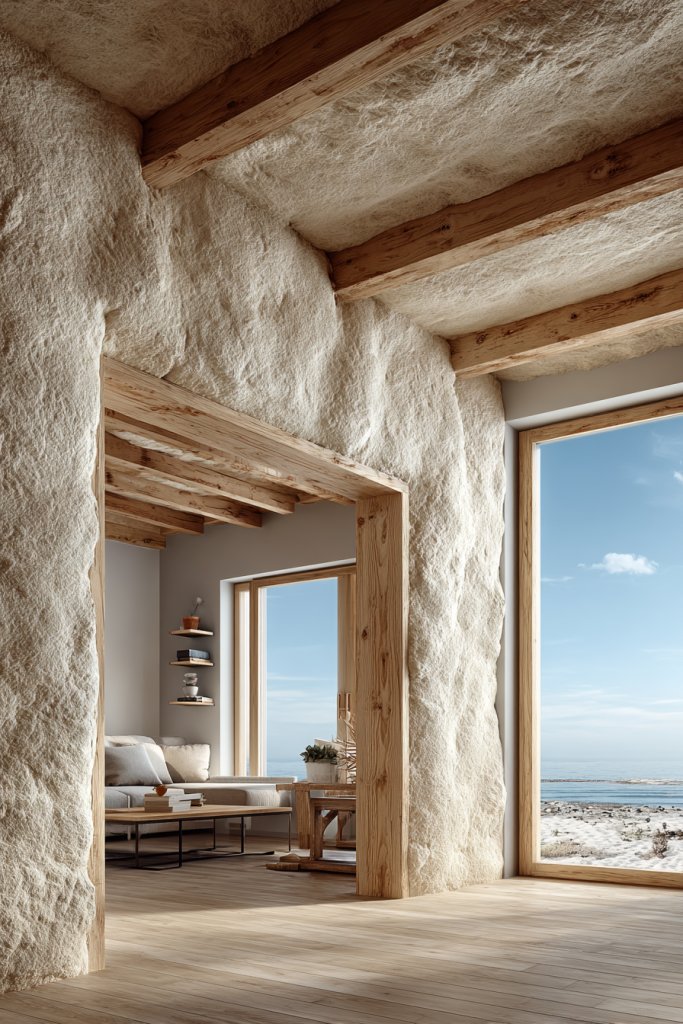
High utility bills and uncomfortable indoor climates are common frustrations. An energy-efficient home saves you money and creates a more comfortable living environment. Proper insulation and ventilation are the backbone of this, reducing energy waste and ensuring fresh air circulation. It’s an investment in comfort that pays off over time.
Imagine thick, high-quality wall insulation concealed behind stylish drywall, keeping the warmth in during winter and the heat out in summer. Cross-ventilation is facilitated by strategically placed operable windows and vents, allowing breezes to flow through. The home feels naturally cool or warm without relying heavily on HVAC systems, with energy-efficient windows completing the picture.
Choose insulated window frames with low U-values for maximum efficiency. Incorporate smart ventilation systems, like exhaust fans or air exchangers, to maintain air quality. Use natural shading devices—like overhangs or reflective coatings—to reduce heat gain. Seasonal updates include adding weatherstripping or sealing gaps for better performance.
Work with specialists to select insulation materials suited for your climate—like spray foam, fiberglass, or cellulose. Proper installation is key—inspect for gaps or compression that reduce effectiveness. Install energy-efficient, double-glazed windows and doors to minimize heat transfer. Use passive design strategies like orientation and shading to reduce reliance on artificial climate control. Regular maintenance ensures insulation and ventilation systems work optimally.
Add decorative, energy-efficient window treatments—such as cellular shades or reflective films—that improve insulation without sacrificing style. Incorporate natural airflow pathways and keep vents clean for maximum efficiency. Use smart thermostats and sensors to fine-tune your home’s climate control, saving energy and enhancing comfort. Personalize with eco-friendly materials that align with your values.
An energy-efficient home reduces bills and carbon footprint, making a positive environmental impact. It creates a cozy, consistent indoor climate that improves your quality of life. Smart, sustainable design proves that comfort and savings go hand in hand—your home can be both stylish and responsible.
19. Strategic Placement of Electrical and Lighting Fixtures
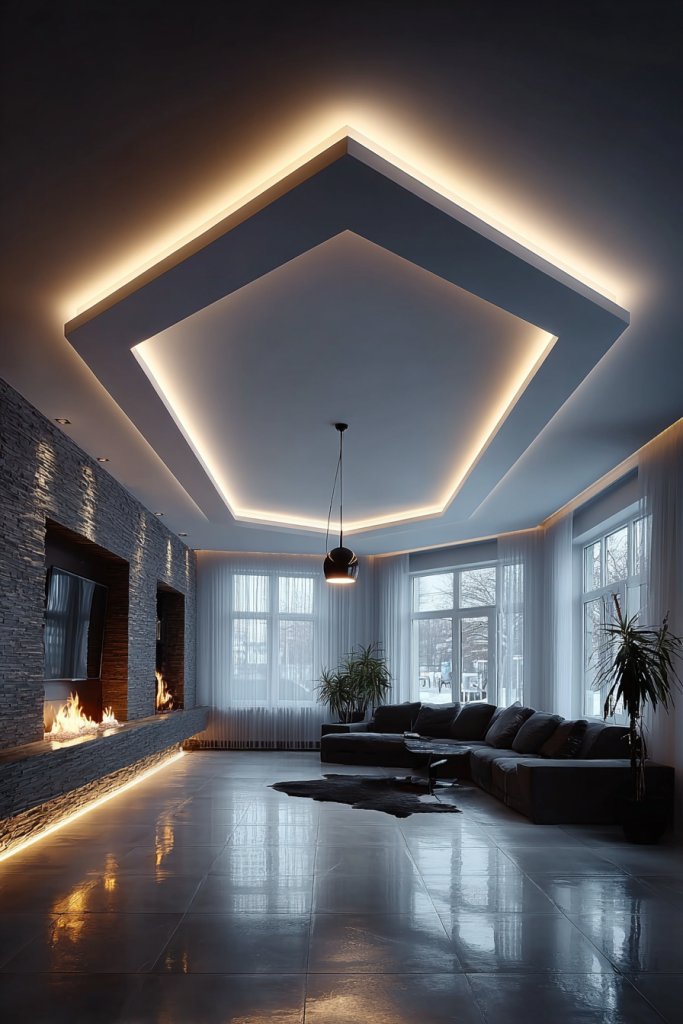
Poor lighting can make even the most beautiful space feel dull and uninviting. Strategic placement of electrical fixtures transforms your home’s ambiance, functionality, and energy efficiency. Well-planned lighting makes every corner work for you—whether for work, relaxation, or entertaining. It’s the secret to creating mood and maximizing space.
Visualize recessed ceiling lights highlighting artwork or architectural features, while wall sconces add soft, indirect glow. Task lighting, like adjustable reading lamps, is placed near seating areas or desks for practicality. Dimmers control mood, from bright and energetic to cozy and intimate. The overall effect is a layered, balanced illumination scheme that enhances every part of your home.
Opt for modern LED fixtures for energy savings and long life. Use decorative fixtures—like vintage pendants or sculptural sconces—to add personality. Incorporate smart lighting systems that allow app control and automation. Seasonal updates include changing shades or bulbs to match your decor or mood.
Plan your lighting layout based on the function of each space—bright task lighting for kitchens, soft ambient light for bedrooms. Install fixtures in key areas first, considering the height and spread of light. Use a mix of overhead, wall-mounted, and accent lighting to create depth. Choose fixtures that blend seamlessly with your decor style for a cohesive look. Test different configurations before final installation.
Add decorative lamps, pendant lights, or sconces that reflect your personal style. Use smart bulbs or dimmers to easily adjust brightness and mood. Incorporate motion sensors or timers for convenience and energy savings. Personalize with unique fixtures or vintage finds that add character and charm.
Thoughtfully placed lighting elevates your home’s aesthetic and functionality. It boosts your mood, improves productivity, and makes your space more inviting. With a clever lighting plan, you turn ordinary rooms into extraordinary ones—proof that details matter.
20. Creative Use of Niche Spaces for Storage or Decor
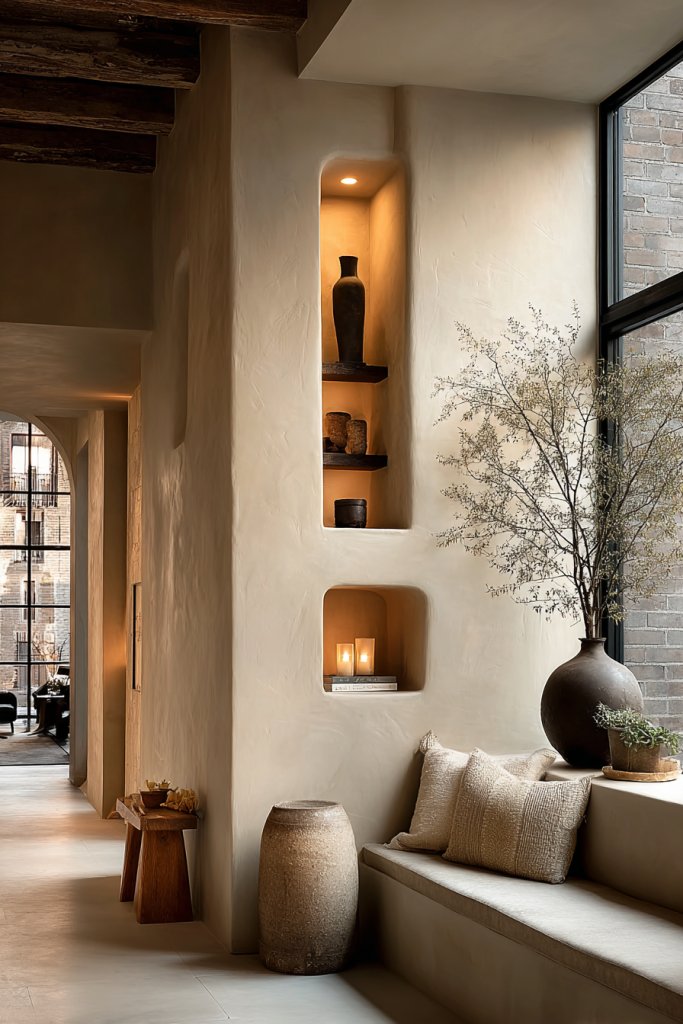
Niche spaces are often overlooked but hold untapped potential for storage or decoration. Cleverly utilizing these areas maximizes space and adds unique character to your home. Whether it’s an alcove, wall cavity, or under-stair spot, niches can be functional or decorative—sometimes both. It’s the art of turning small spaces into big opportunities.
Imagine a small wall niche filled with decorative ceramics or sculptural objects, adding visual interest without cluttering. An under-stair alcove houses a compact bookshelf or a cozy reading nook, with cushions and lighting creating a welcoming retreat. Recessed wall cavities serve as hidden storage for shoes or cleaning supplies, cleverly concealed behind sleek doors. Each niche becomes a focal point, blending form and function.
Decorate niches with textured finishes, wallpaper, or paint that contrasts with surrounding walls for emphasis. Use built-in shelving or drawers for practical storage, or add LED lighting inside for dramatic effect. Seasonal updates include switching decorative objects or changing paint colors to refresh the space. Adapt niches to your needs—display, hide, or a mix of both.
Identify areas that can be recessed or built into existing walls, working with contractors for seamless integration. Install shelves, cabinets, or decorative panels that fit your space and style. Use lighting solutions—like LED strips or puck lights—to highlight the niche and add ambiance. Ensure structural integrity and proper finishing for a polished look. Regularly update the decor or contents to keep it fresh.
Add personal touches with themed objects, textured finishes, or color accents that match your decor. Use decorative lighting to draw attention or create mood. Incorporate seasonal or personalized items that tell your story. Keep clutter out of visible niches to maintain a clean, curated feel.
Creative use of niches turns overlooked spaces into design highlights. They add depth and personality while optimizing storage. Small details like these elevate your home’s style and function, making every inch work harder for you—proof that clever design can truly transform a space.
21. Use of Textured Wall Finishes for Visual Interest
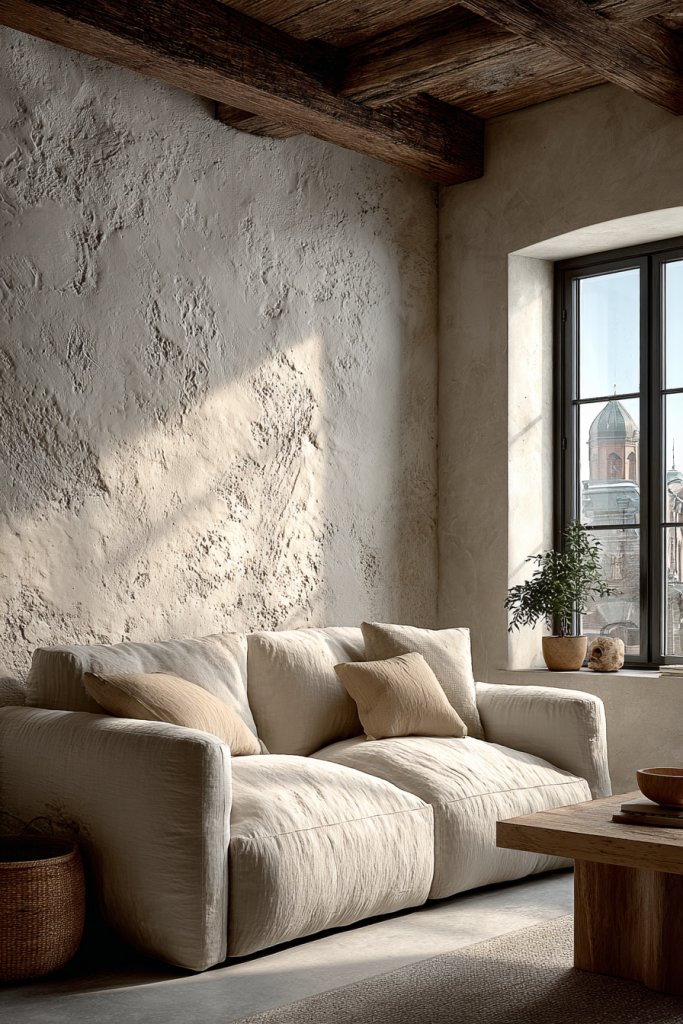
Flat, monotonous walls can make a room feel uninspired. Textured wall finishes add depth, character, and a tactile element that elevates your decor. They’re the perfect way to create visual interest without clutter or excessive decor. It’s an easy upgrade that transforms plain walls into statement features.
Picture a feature wall with textured stucco or plaster finish, catching light and shadow as you move through the room. Subtle patterns like vertical lines, geometric shapes, or embossed motifs add sophistication. The textures create a layered effect, making surfaces appear richer and more inviting. Paired with minimalist furniture, these walls serve as a focal point that draws the eye.
Choose from a variety of textures—like Venetian plaster, textured wallpaper, or carved wall panels—to match your style. Use neutral tones for a calming effect or bold colors for drama. Incorporate textured finishes in key areas—fireplaces, entryways, or accent walls—to highlight their importance. Seasonal updates involve changing wall treatments or adding decorative panels.
Consult with a professional to select the right textured finish for your space and budget. Prepare surfaces by cleaning and smoothing, then apply the chosen material according to manufacturer instructions. Use specialized tools—like trowels or rollers—for textured effects. Finish with protective coatings if needed. Regular maintenance involves cleaning dust or fingerprints gently to preserve texture.
Pair textured walls with minimalist art, sleek lighting, or contrasting paints to enhance their impact. Incorporate metallic or gloss finishes for extra shine and depth. Use textured wall finishes to define specific areas or zones within open spaces. Personalize with custom patterns or motifs that tell your story.
Textured walls add a layer of depth and luxury, making your home more engaging. They reflect your style and elevate the overall aesthetic, proving that details matter. With a little effort, your walls can become the highlight of your decor, inspiring confidence in your design choices.
22. Low-Maintenance Flooring Options for Practical Living
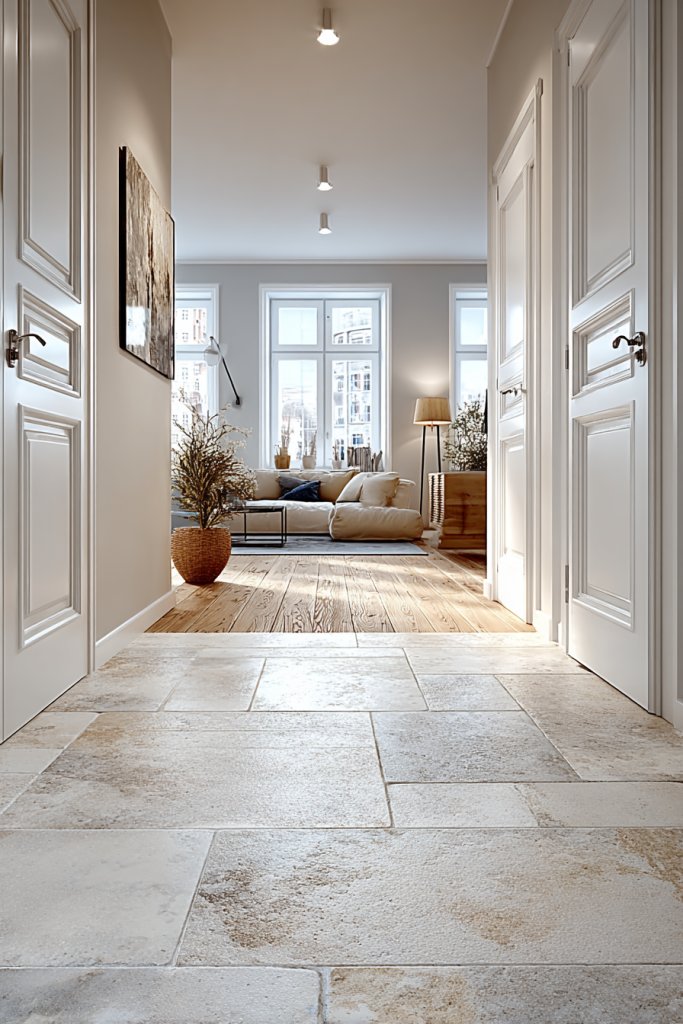
Flooring is the foundation of your home’s style and durability, but high-maintenance materials can be a hassle. Low-maintenance flooring options save you time, effort, and money, while still looking fabulous. They’re perfect for busy households or anyone who prefers a fuss-free lifestyle. Practical doesn’t have to mean boring.
Imagine a polished concrete floor with a sleek, industrial vibe, or luxury vinyl planks that mimic hardwood with added durability. These floors resist scratches, stains, and wear, maintaining their beauty with minimal upkeep. Textured surfaces or matte finishes hide dirt and fingerprints, keeping your home looking fresh longer. The overall aesthetic is modern, clean, and effortlessly stylish.
Choose from durable materials like vinyl, laminate, or polished concrete for a variety of looks—from rustic to contemporary. Use textured or patterned tiles to add visual interest, especially in bathrooms or kitchens. Seasonal updates include replacing rugs or adding textured runners to protect high-traffic zones. These floors work well in busy households, pet-friendly homes, or rental properties.
Select flooring based on your foot traffic, moisture levels, and aesthetic preferences. Professional installation ensures proper sealing and leveling for longevity. Maintain by sweeping regularly and using gentle cleaners suited for your material—avoid harsh chemicals that can damage finishes. For added durability, consider protective coatings or sealants. Replace worn or damaged sections as needed to keep the floor looking new.
Add area rugs or textured runners to introduce color and comfort, and to protect high-wear areas. Choose rugs with easy-to-clean fabrics or removable covers for convenience. Use coordinated colors or patterns to tie spaces together, and layer rugs for visual interest. Keep your flooring area clutter-free for a pristine look.
Practical flooring options make your home maintenance simpler while staying stylish. They support a busy lifestyle without compromising on design. When your floors are durable and easy to care for, you gain peace of mind and more time to enjoy your beautiful space—proof that practicality and style can coexist.
23. Smart Home Technologies for Convenience and Efficiency
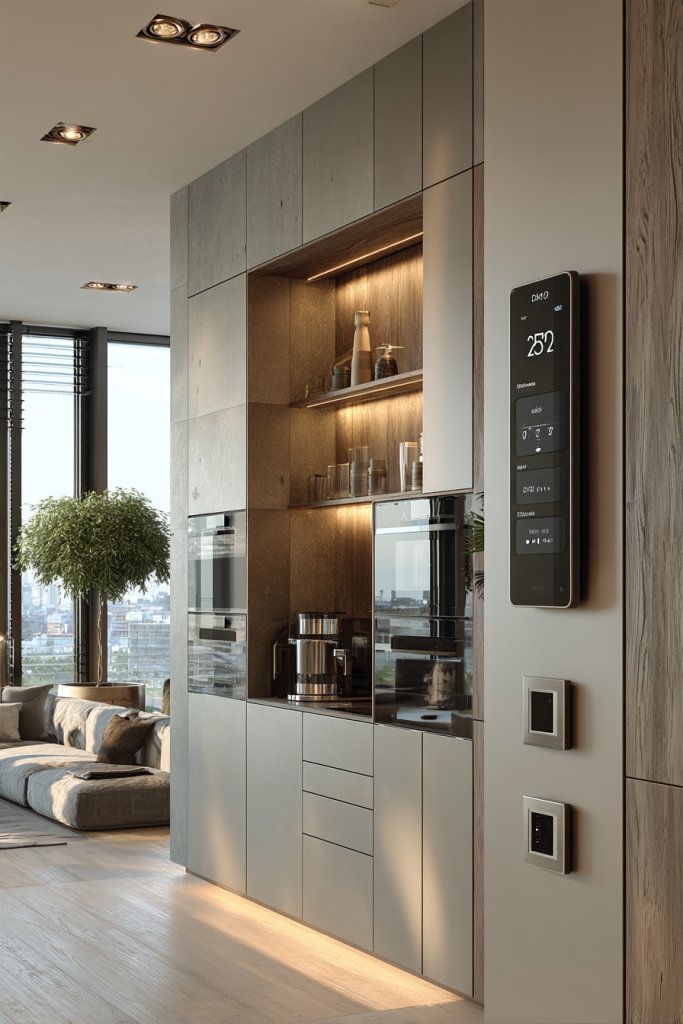
Managing multiple devices and routines can be overwhelming. Smart home technologies simplify daily life, increase energy efficiency, and add convenience at the touch of a button. From lighting to security, these innovations make your home smarter and more responsive to your needs. It’s about working less and living more.
Picture voice-controlled lighting that dims automatically as you settle in, or a smart thermostat that learns your schedule and adjusts accordingly. Security cameras and doorbells keep you connected, while app-controlled locks offer peace of mind. All devices work seamlessly together, creating a cohesive, high-tech environment that adapts effortlessly to your lifestyle.
Choose sleek, minimal devices that blend into your decor—like flush-mount sensors or hidden hubs. Incorporate voice assistants, smart speakers, or touchscreens that serve as control centers. Seasonal updates include new features or integrations, ensuring your system evolves as technology advances. Focus on systems that are user-friendly and scalable.
Start with a central hub compatible with your preferred devices. Install smart lighting in key areas—like kitchens and hallways—for automation and ambiance control. Connect thermostats, security, and entertainment systems for a unified experience. Use apps for remote management, and set routines or schedules for energy savings. Regular updates and security patches keep your system secure and functional.
Customize your system with personalized routines—like turning lights on at sunset or locking doors at bedtime. Integrate voice commands or motion sensors for hands-free control. Use aesthetic device covers or mounts that match your decor, and add voice or app notifications for alerts or reminders. Personal touches make your smart home uniquely yours.
Smart technologies elevate your home’s efficiency, security, and comfort, making daily routines effortless. They demonstrate that innovation can be simple and accessible, inspiring confidence in your tech choices. Embrace the future of living and enjoy a home that works for you—smart, stylish, and seamless.
24. Design Focused on Accessibility and Ease of Movement
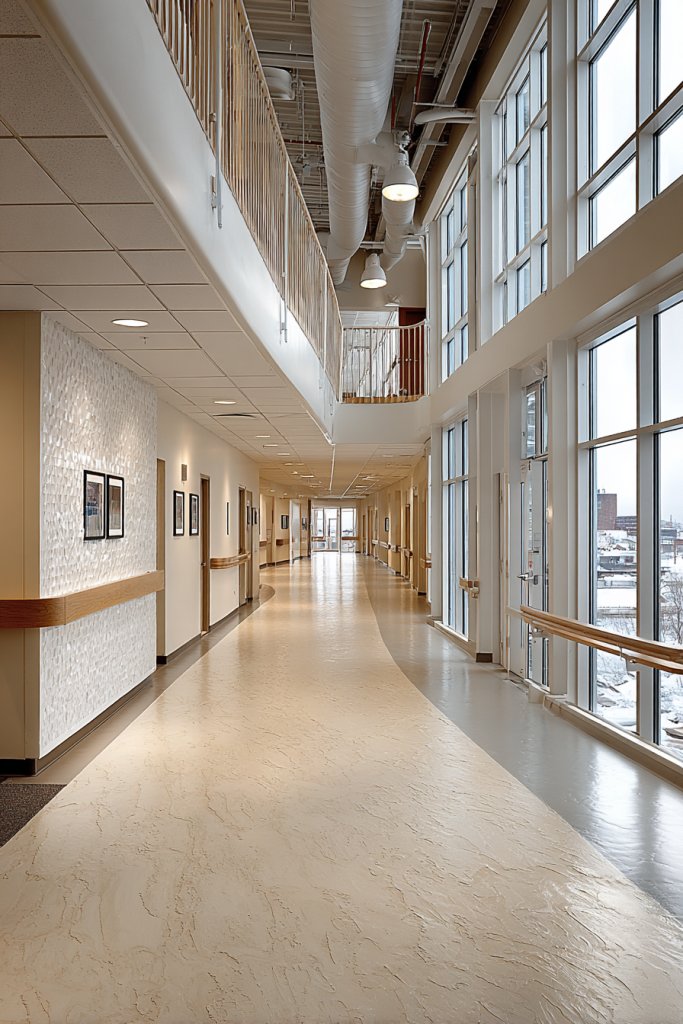
Navigating a home should be effortless for everyone, regardless of age or ability. Poor design can turn simple movements into challenges, creating frustration and limiting independence. Accessibility-focused design ensures your home is welcoming, safe, and easy to move through—making life easier for all.
Imagine wide doorways with smooth thresholds, eliminating trip hazards. Hallways are clear and unobstructed, with furniture arranged to allow easy circulation. Controls and switches are positioned at comfortable heights, and lever handles replace knobs for effortless operation. The overall layout is open, intuitive, and safe—facilitating movement with confidence and ease.
Use low-threshold or ramped entries to improve access, especially for wheelchairs or strollers. Choose furniture with rounded edges and avoid cluttered pathways. Incorporate adjustable-height counters and sinks in kitchens and bathrooms. Seasonal updates could include adding tactile or high-contrast elements for better visibility and safer navigation.
Plan your layout with wide clearances—at least 36 inches—around furniture and fixtures. Select hardware and fixtures designed for ease of use—like lever handles or touch-activated switches. Install grab bars or handrails where needed, and ensure all flooring is slip-resistant. Use visual cues or contrasting colors to delineate different zones and pathways. Regularly review and update for safety and comfort.
Add personalized touches like decorative grab bars or tactile signs that match your decor. Incorporate ergonomic furniture and accessories designed for comfort. Use lighting that adjusts automatically or can be dimmed for different needs. Keep pathways clutter-free and well-lit for maximum safety and ease.
Designing for accessibility enhances your home’s functionality for everyone. It creates a safer, more inclusive environment that supports independence and peace of mind. With thoughtful planning, your home can be both beautiful and universally accessible—proof that good design benefits all.
25. Personal Touches with Functional Decor Elements
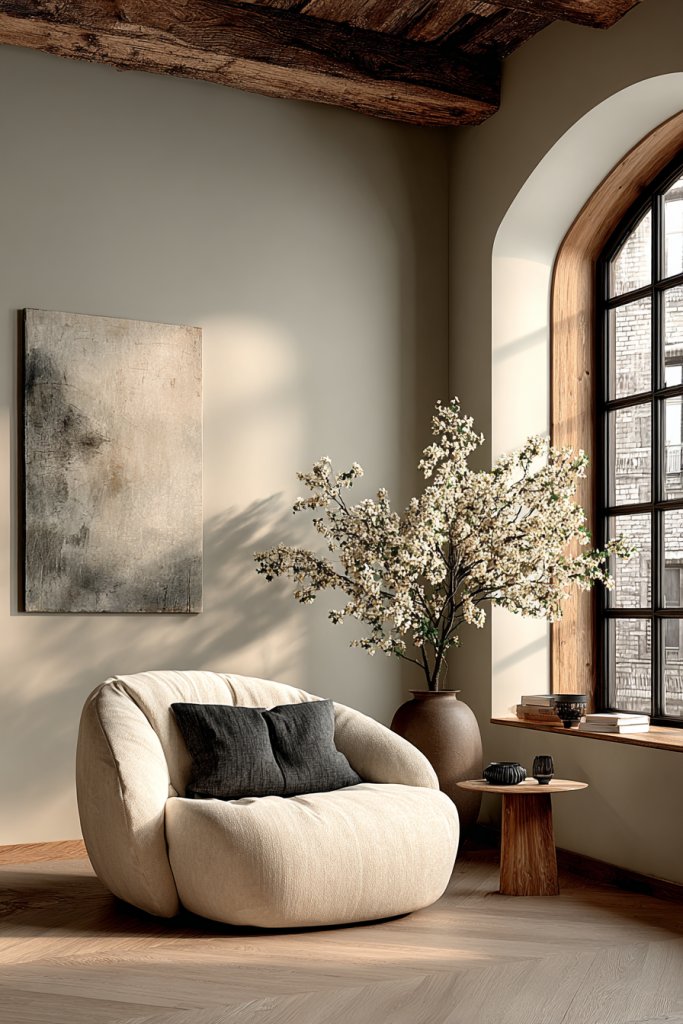
A home that feels personal and welcoming is more than just beautiful—it reflects who you are. Functional decor elements blend style with practicality, making your space both attractive and useful. It’s the key to creating a home that’s uniquely yours, without sacrificing function.
Picture a sleek wall clock with a minimalist design, a set of stylish storage baskets, or a decorative tray that doubles as a catch-all for keys and mail. These pieces add personality and convenience, effortlessly combining form and function. Textured throws, cozy cushions, or decorative hooks enhance visual interest while serving a purpose. The space feels curated, comfortable, and distinctly personal.
Choose decor in your favorite colors, textures, and styles—modern, rustic, boho, or eclectic—that reflect your personality. Incorporate multi-use items like a decorative storage ottoman or a vintage trunk for extra storage with character. Seasonal updates include swapping out accessories or adding decorative accents like candles or art pieces that align with your mood.
Start with key functional elements—like a stylish coat rack, a multi-purpose tray, or a decorative mirror—that suit your lifestyle. Use quality materials that withstand daily use, and place them where they’ll be most useful. Mix decorative objects with practical ones to keep the space balanced and inviting. Regularly refresh your accessories to keep your home feeling lively and personal.
Add personal touches with custom-made or meaningful objects—like family heirlooms or travel souvenirs—integrated into your decor. Use textured textiles or metallic accents to elevate simple pieces. Incorporate visual layers with plants, artwork, or decorative lighting that reflect your personality. Keep the overall look cohesive but personalized.
Personal touches turn a house into a home, making every space feel warm and inviting. They showcase your style and create a sense of belonging. Thoughtful, functional decor elevates your everyday living experience—proof that personal and practical can coexist beautifully.
Conclusion
Exploring these diverse single floor house design ideas reveals countless ways to create a functional and beautiful living space. From modern minimalism to charming rustic styles, the possibilities are endless and exciting. Don’t hesitate to try out these concepts in your own home—your perfect, efficient, single-story sanctuary is within reach. Start transforming your space today and embrace the comfort and convenience of single-floor living!